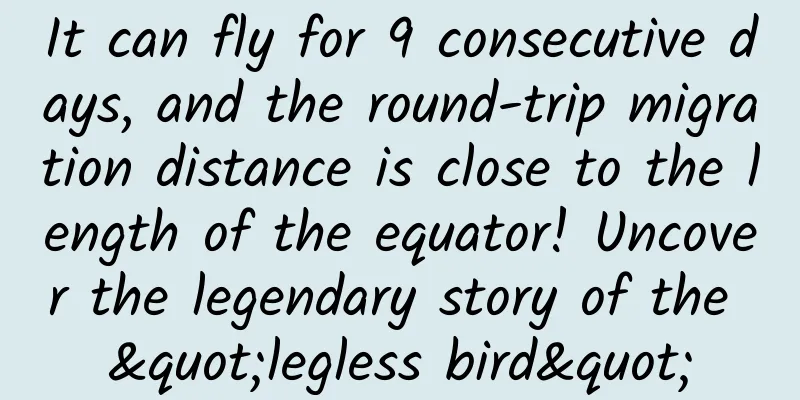It can fly for 9 consecutive days, and the round-trip migration distance is close to the length of the equator! Uncover the legendary story of the "legless bird"

|
Beijing has always been an important breeding ground for the Beijing Swift. Why is it called the "bird without feet" and why is it known as the "flash that never lands"? How far does it travel each year? Interview experts: Zhao Xinru (Associate Professor of Zoology, Beijing Normal University) Guo Geng (Researcher at Beijing Biodiversity Conservation Research Center) For many residents living in Beijing, the Beijing Swift, known as the "elves" of the city, is a very familiar species. However, they are not aware of some of the legends that happened to them. ▲Beijing Swift Photosensitive locators reveal the secrets of swifts' long-distance migration Beijing has always been an important breeding ground for Beijing swifts. The Beijing swifts stay here from mid-April to mid-to-late July every year. During these three months, the swifts have to complete the work of laying eggs, incubating and raising chicks. After mid-to-late July, all the Beijing swifts fly away at once. Where do they go? To track the migration path of swifts, the first thing people think of is to put metal leg rings on Beijing swifts and release them back into the wild, and then uncover the mystery of Beijing swifts' migration through recapture, field observation, radio tracking or satellite tracking. However, Zhao Xinru, an ornithologist at Beijing Normal University, told reporters that the recovery of ring information has its limitations, because the geographical information records of recovered individuals are accidental and rely on the reports of discoverers along the bird's migration route, and the information is very difficult to obtain. On May 24, 2014, researchers installed a miniature photosensitive locator on the backs of 31 Beijing swifts at the Bafang Pavilion on the Kunming Lake in the Summer Palace in Beijing. The net weight of this photosensitive locator is only 0.65 grams, less than 3% of the weight of the Beijing swift. It is light and compact, has little impact on the flight of the swifts, and has a long flight time. More importantly, the photosensitive element on the locator will record the solar altitude angle and the sunrise and sunset times. If the swifts wearing the locator are recovered and the data recorded by the locator is downloaded, the researchers can analyze the approximate location of the Beijing swifts every day. ▲ Associate Professor Zhao Xinru is installing a micro photosensitive locator on the Beijing swift In May 2015, researchers recovered 13 Beijing swifts out of 31 carrying micro-photosensitive locators at the Bafang Pavilion in the Summer Palace. Based on the data recorded by the locators, the migration routes of these swifts were accurately analyzed. Data research shows that starting from mid-to-late July every year, Beijing swifts begin to migrate to their wintering grounds after completing their breeding mission. They set out from the Summer Palace in Beijing, fly northwest, enter Inner Mongolia, Xinjiang and other places, cross the Tianshan Mountains, and then pass through several Central Asian countries, flying southwest in a large arc. After passing through Iran, Iraq, Saudi Arabia, and crossing the Red Sea into the African continent. Then, the Beijing swifts will go all the way south, passing through Somalia, Ethiopia, Kenya and other countries, and finally arrive at Namibia, South Africa, and Botswana at the southern tip of the African continent in late October and early November. This is the main wintering ground for Beijing swifts. Around February of the following year, the Beijing swifts set off to return to Beijing, and the route is basically the same as the wintering migration route. Around April, after a long flight, the Beijing swifts will return to the Summer Palace in Beijing. ▲Beijing Swift Migration Route Map (Map by Zhang Lin) Although this is only the approximate migration route of a small number of Beijing swifts wearing light-sensitive locators, it reflects the amazing flying ability of Beijing swifts. According to statistics, the migration route of swifts passes through more than 20 countries, with a round-trip distance of about 38,000 kilometers, which is almost the length of the earth's equator. The Flash who never lands Generally speaking, in addition to flying in the sky, most birds also need to find a place to rest every day. Guo Geng, a researcher at the Beijing Biodiversity Conservation Research Center, said that Beijing swifts are different. They can fly in the sky for a long time without having to land to rest. Compared with house martins, Beijing swifts are larger, with narrower and longer wings. They are extremely powerful in flight, with a maximum flight speed of 48 meters per second, which is equivalent to 172.8 kilometers per hour. Tracking shows that swifts can fly for nine consecutive days, and can fly up to 830 kilometers a day. Why does the Beijing Swift have such amazing flying ability? This is related to its body structure. The Beijing Swift has a streamlined body and its wings bend backwards like a sickle when flying, which allows it to fly quickly and smoothly. The food of Beijing swifts is various insects flying in the sky. When they drink water, they skim over the water like dragonflies. They even mate in the air by sliding down. Even when they sleep, they fly in the air at a speed of 8.5 meters per second. ▲Flight record of Beijing Swift (Map by Zhang Lin) In the animal world, Beijing swifts use a unique sleep mode called "half-brain slow-wave sleep", which means half of the brain is asleep while the other half is still awake. Many aquatic mammals and birds have this ability, for example, dolphins also have this half-asleep and half-awake sleep mode, and even our domestic chickens have this ability. This sleep state can ensure that they remain alert while resting, which is more conducive to their survival in nature. ▲The four toes of the Beijing Swift are all stretched forward, and the toes cannot hold together, so it is unable to grab branches to perch. Guo Geng said that it is precisely because they live in the sky that the two feet of Beijing swifts are atrophied, and the four toes are stretched forward. The toes cannot hold each other, and they cannot grab branches to perch. They are also called "birds without feet". Therefore, they never land on vegetation. Once they land, it is difficult to take off without external force. Therefore, when landing, swifts can only grab on to vertical surfaces such as cliffs or walls, so that they can take off at any time. As long as they jump from mid-air and glide, they can fly. Why are swifts so obsessed with Beijing? Although swifts spend most of their lives in the sky, they still have to reproduce and maintain the development of the population. Although they can mate in the air, they still have to find a stable place to lay eggs, hatch and raise chicks. Therefore, when they become adults at the age of three or four, swifts must land and find various caves and crevices to reproduce. Zhao Xinru said that swifts are climbing birds, suitable for climbing on cliffs and caves. Originally, they could only cling to the cracks of bare rocks and the edges of caves, and could only take off by swooping down from a height and flapping their wings. However, in the long-term evolution, the Beijing swift has gradually become a bird that accustomed to building nests and breeding under the eaves of man-made buildings or in the cracks of the walls. ▲Beijing Swifts in the Summer Palace Why did the Beijing Swifts choose Beijing? Guo Geng believes that this has a lot to do with the fact that a large number of ancient buildings in Beijing provide a good environment for swifts to lay eggs, hatch and raise chicks. Although the history of swifts is much older than that of Beijing, before the establishment of Beijing, they could build nests and raise chicks in caves and cracks like some swifts in other places. However, since the establishment of Beijing, they have discovered the benefits of building nests and raising chicks in a large number of wooden structures, and then gradually formed a habit. Especially after Emperor Chengzu of the Ming Dynasty moved the capital, Beijing successively built the Forbidden City, the Bell and Drum Tower, the Temple of Heaven and other royal buildings and dozens of towers and arrow towers. The beams, purlins and rafters in these tall buildings are staggered to form artificial caves one after another, which are not only safer and more comfortable than bare rocks in the wild, but also conducive to the clustered breeding of swifts. Swifts with long wings and small bodies "prefer" to build nests in the gaps between the rafters and purlins of ancient buildings with bracket structures. In this way, after they fold their wings, they can hide in a small and hidden space, which is conducive to hatching eggs and raising chicks, and effectively prevent predation by natural enemies. It is for this reason that Beijing has become an important breeding ground for Beijing swifts. In the three northern regions of my country and Inner Mongolia, wherever there are concentrated ancient buildings, they are the places where Beijing swifts yearn for breeding. In the memories of many old Beijingers, from the Temple of Heaven to the Imperial Ancestral Temple, from the Forbidden City to the Lama Temple, from the city towers and arrow towers to the Eight-sided Pavilion and East Palace Gate in the Summer Palace, swifts fly in groups around the buildings, forming a vivid ancient capital style. When you look up at Qianmen, Zhengyangmen, Tiananmen, the Forbidden City, and Jingshan, you can see swifts flying around the city towers. Beijing swifts have become a part of Beijing. There are still secrets hidden in swifts that need to be solved Zhao Xinru said that although the Beijing Swift only stays in Beijing for about 100 days each year, it is an important bird in Beijing. There are very few wild species in the world that use "Beijing" as their model origin. The Beijing Swift is also the only bird in the world named after "Beijing". Therefore, the Beijing Swift is regarded by many people as a symbol of Beijing and has become a special natural and cultural landscape in this ancient city. One of the prototypes of the 2008 Beijing Olympic mascot "Nini" is the Beijing Swift. However, Zhao Xinru said that the Beijing swift is a symbolic species of Beijing, which is only a saying and initiative among bird lovers and bird researchers in Beijing. The research on indicator species started relatively late in my country, and Beijing has not yet determined the relevant indicator species for environmental ecological assessment. The Beijing swift does have such "qualifications". For example, if there are many swifts in a place, it means that there are many insects and rich species here, which can be used as an indicator of ecological diversity. At present, some statistics show that the number of Beijing swifts in Beijing city is about 6,000-7,000. Some experts believe that this shows that their number should be showing a gradual increasing trend. ▲Beijing swifts hovering over the Hall of Prayer for Good Harvests at the Temple of Heaven Although Beijing swifts are often close to many Beijing citizens, it is difficult for researchers to study them because they spend most of their lives in the sky. Humans still know very little about swifts, and there are still many secrets about them that need to be uncovered. "It's only in recent years that we've come to understand their migration routes. Much of our previous knowledge was wrong." Guo Geng said that with the development of science and technology, scientists' tracking and research on swifts will become more and more in-depth. Written by reporter Li Peng, Photo and text editor Chen Yongjie New Media Editor/Liu Daheng Image source/Visual China (except those with signature) Produced by: Science Central Kitchen Produced by: Beijing Science and Technology News | Science Plus Client Welcome to share to your circle of friends Source: Science Plus |
>>: Bugs that don’t bite are all alike, but bugs that bite each have their own weapons!
Recommend
What else do banks do besides lending my money and making money?
The 2022 Nobel Prize in Economics was awarded to ...
Refined operation strategy for users in the education and training industry
Of course, it may also be because I don’t know en...
To complete his research, he took clams that his daughter had picked up from the beach.
"Go to the hospital and get an MRI." Ar...
Xiaohongshu KOL promotion: the secret of Xiaohongshu’s operational thinking!
Many people may be confused here. Why is doing we...
A must-read every year: analysis of consumption propositions and marketing trends of new main groups
It’s graduation season again. Most of those born ...
How should a company operate a popular Douyin account?
There is no need to say much about the popularity...
Forbes columnist: Why I said Xiaomi wants to acquire Xunlei
[[138837]] Yesterday, Xunlei CEO Zou Shenglong pu...
618 JD Marketing Teaches You How to Create a Differentiated IP
Although 618 brings with it scarce and large traf...
Traditional TV brands avoid talking about price wars. Are they fearless or powerless?
The China Digital TV Annual Ceremony is known as ...
iPhone system is getting harder to use, Apple is forcing more users to switch to Android
In the eyes of many people, Apple's iPhone ha...
The 3-step fission method used by all fission masters
In this article, we will talk about fission. It i...
Detailed explanation of JSPatch implementation principle: Let JS call/replace any OC method
JSPatch is a small-sized JavaScript library that ...
Sichuan Xunniu March Chan Theory Basic Course
Introduction to the resources of the March Chaos ...
5 ways to promote your brand!
Brand promotion is not just a high-sounding conce...
Xiaohongshu promotion strategy: the road to brand self-upgrade!
1. Explosive growth Xiaohongshu has been extremel...




![[Original Artifact] Automatically edit short videos with one click, and generate 100 original videos in one second (software + video)](/upload/images/67cbfd3c31d05.webp)




